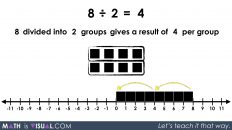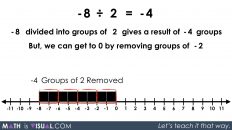In This Set of Math Visual Prompts…
Students will explore modelling and solving two-step algebraic equations involving multiplication and division.
Intentionality…
This set of visual math talk prompts is taken from the Math Talk section of Day 2 in the Make Math Moments Problem Based Unit called Planting Flowers Revisited. The purpose of the Math Talk is to reinforce key concepts and big ideas from this problem based math unit including:
- There are two types of division;
- Quotative division is when the total quota is known (the dividend), and the number per group or the rate (the divisor) is known;
- Quotative division reveals the number of copies or iterations of a rate that can be derived from the overall quota (the dividend);
- In quotative division, the dividend and the divisor have the same unit;
- The dividend from any division sentence can be decomposed into smaller parts to allow for friendlier division by the divisor. This strategy is known as partial quotients. (i.e.: 85 ÷ 5 = 45 ÷ 5 + 40 ÷ 5 = 9 + 8 = 17);
- Division is the inverse operation of multiplication;
- Variables are used to represent changing or unknown quantities;
- When solving an equation where the coefficient of the unknown variable is not equal to 1, division is required to determine the value of the unknown variable and the context of the problem determines which type of division is required.
Unsure about some of the terminology listed above?
Learn more about multiplicative thinking, rates, ratios and the roadmap to proportional relationships through the course: The Concept Holding Your Students Back.
Preparing to Facilitate
Present the following equations one at a time. Encourage students to describe a context that could be represented by each. All of today’s equations and contexts should be quotative. Meaning, the rate is known, the number of groups is unknown.
For example:
An unknown number of tulip bulbs at a cost of $4/tulip (the rate is known) were purchased, plus a two dollar donation was made to the World Wildlife Fund. If the total sale was $26, how many tulip bulbs did the customer buy?
Students should use a model of their choice to solve and/or represent their thinking.
n(4) + 2 = 26
(26 – 2) ÷ 4 = n
Four (4) additional visual math prompts are shared in the Teacher Guide from Day 2 of the Planting Flowers Revisited problem based math unit.
Consider leveraging the visual math talk prompt animations below to help you prepare to facilitate this math talk. The purpose of this math talk is to build fluency with solving two step equations requiring quotative division and to reveal that multiple equations can be written to represent one situation or context.
Visual Math Talk Prompt #1
During the first visual math talk prompt, be ready to pause the video to provide students with think time.
In the video, students are presented with visuals to set the context involving a purchase of tulip bulbs and a donation to the World Wildlife Fund (WWF).
The prompt is:
How many tulip bulbs did the customer buy?
While you could allow students to solve this problem utilizing the strategy and model of their choice, you might consider pushing students to also write an algebraic equation that could represent this problem. This is a teacher move that you will need to consider depending on the readiness of your group as to whether nudging in this direction is appropriate at this point or whether making the connection to the equation after solving is the better option.
![Planting Flowers - Revisited [Day 2] Purposeful Practice - 01 - MATH TALK Prompt Image 001](https://mathisvisual.com/wp-content/uploads/2021/09/Planting-Flowers-Revisited-Day-2-Purposeful-Practice-01-MATH-TALK-Prompt-Image-001-1024x576.jpeg)
Although students are free to leverage a strategy of their choosing, do your best to try and represent student thinking using a linear model like a stacked bar model (seen below) or a double number line. While the student may not have represented using this particular model, ensure that you are asking students for permission to represent their thinking in this way.
![Planting Flowers - Revisited [Day 2] Purposeful Practice - 01 - MATH TALK Prompt Image 002](https://mathisvisual.com/wp-content/uploads/2021/09/Planting-Flowers-Revisited-Day-2-Purposeful-Practice-01-MATH-TALK-Prompt-Image-002-1024x576.jpeg)
Consider using prompts like:
Is it alright if I represent your thinking this way?
And
Do you see your thinking represented on this stacked bar model?
From this visual model, students may then be able to better understand and explain their thinking of how they solved for the number of tulip bulbs knowing that the rate was $4 per bulb.
![Planting Flowers - Revisited [Day 2] Purposeful Practice - 01 - MATH TALK Prompt Image 003](https://mathisvisual.com/wp-content/uploads/2021/09/Planting-Flowers-Revisited-Day-2-Purposeful-Practice-01-MATH-TALK-Prompt-Image-003-1024x576.jpeg)
Some students may choose to partition the rest of the stacked bar model by starting at $4 to 1 tulip bulb and skip count by that ratio of $4 to 1 bulb until they arrive at $24 and 6 tulip bulbs.
Others may immediately recognize that since the cost of the tulip bulbs was $24, we can quotatively divide $24 by $4 to reveal the scale factor of 6. Therefore, scaling 1 tulip bulb up by a factor of 6 will reveal 6 as the number of tulip bulbs purchased.
![Planting Flowers - Revisited [Day 2] Purposeful Practice - 01 - MATH TALK Prompt Image 004](https://mathisvisual.com/wp-content/uploads/2021/09/Planting-Flowers-Revisited-Day-2-Purposeful-Practice-01-MATH-TALK-Prompt-Image-004-1024x576.jpeg)
Showing the scale factor of 6 to scale up from $4 to 1 tulip bulb and the scale factor of 1 sixth to scale down from $24 to n tulip bulbs to $4 to 1 tulip bulb is an important relationship to explicitly highlight.
![Planting Flowers - Revisited [Day 2] Purposeful Practice - 01 - MATH TALK Prompt Image 005](https://mathisvisual.com/wp-content/uploads/2021/09/Planting-Flowers-Revisited-Day-2-Purposeful-Practice-01-MATH-TALK-Prompt-Image-005-1024x576.jpeg)
Finally, if students were not prompted to write an equation initially, be very intentional about prompting students to write an equation and make connections to the strategies and models shared to solve for the number of tulip bulbs purchased.
Visual Math Talk Prompt #2
Continue the video and be ready to pause when prompted at the second visual math talk prompt.
In this visual, we flip the script a bit here and rather than giving students enough information to solve the problem from the visuals, we share this prompt:
Use the context of cost and number of tulip bulbs to explain what the following equation might represent:
(26 – 2) ÷ 4 = n
You’ll notice that the only information shown in the images is the total cost of the bill which is $26.
At this point, we’re pushing students to engage in some sense making around the algebraic equation to hopefully allow them to reason through and realize that this algebraic equation is actually equivalent to the equation that was shared in the first prompt, n(4) + 2 = 26.
![Planting Flowers - Revisited [Day 2] Purposeful Practice - 02 - MATH TALK Prompt Image 001](https://mathisvisual.com/wp-content/uploads/2021/09/Planting-Flowers-Revisited-Day-2-Purposeful-Practice-02-MATH-TALK-Prompt-Image-001-1024x576.jpeg)
Although it might not be immediately obvious to students, this algebraic equation is actually modelling the use of opposite operations to solve the first equation, n(4) + 2 = 26.
For students who come to this realization quickly, be sure to nudge them to be convincing which means modelling this behaviour using a stacked bar model or other mathematical model of their choosing.
![Planting Flowers - Revisited [Day 2] Purposeful Practice - 02 - MATH TALK Prompt Image 002](https://mathisvisual.com/wp-content/uploads/2021/09/Planting-Flowers-Revisited-Day-2-Purposeful-Practice-02-MATH-TALK-Prompt-Image-002-1024x576.jpeg)
It is likely that students will leverage the model we shared in the first visual prompt as using it will mean that their “work” to explain and convince is already complete.
Want to Explore These Concepts & Skills Further?
Four (4) additional math talk prompts are available in Day 2 of the Planting Flowers Revisited problem based math unit that you can dive into now.
Why not start from the beginning of this contextual 5-day unit of real world lessons from the Make Math Moments Problem Based Units page.
Did you use this in your classroom or at home? How’d it go? Post in the comments!
Math IS Visual. Let’s teach it that way.




Add comment